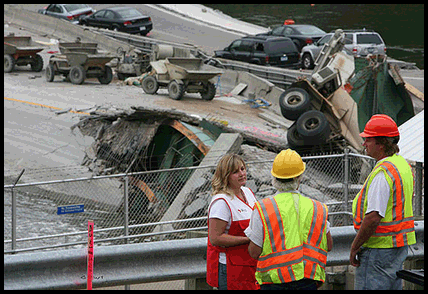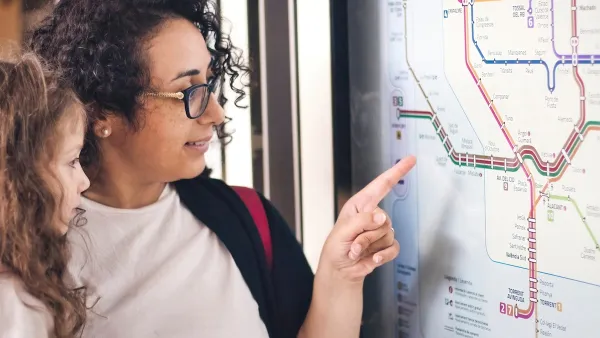Martin H. Krieger compares the lack of oversight involved in today's financial crisis with the transparency and responsibility involved in making bridges.

The Minnesota bridge collapse of 2007. (photo courtesy of The Red Cross)
It is by now well known that about forty years ago a revolution took place in finance (the "quants") that allowed for a more efficient and inventive system. The basic assumptions were that "events" were independent of each other, so that whatever happened to a security or to a society there was no information available that could be used to predict other events. Events were random. One made models of society and finance that were so simple they could have been invented by mathematicians or physicists of about 1900, and in fact they were. Institutions had simple relationships with each other. And third, it was proved again and again, that market processes were efficient and effective (except when there was too much turbulence, and then all bets were off).
Well, the revolution has come a cropper, and it is important that we know why. The best answers are those understood by engineers for why technological devices fail, why bridges fall down, why systems become unstable and crack and fail. The image of Galloping Gertie, the Tacoma Narrows Bridge, twisting in the wind is iconic. Resonances among the bridges elements made for large coherent movements: assumptions of randomness and independence had broken down. For other bridges or electrical systems, a particular part fails catastrophically and the failure or crack then propagates through the system rather than remaining local and confined. There are complex interconnections among the system's parts and so there are collective vulnerabilities that are larger than any single one. And it is proven again and again that you have to look at nonlinear and complex processes, where the engineer is most talented, rather than the nice simple ones of the physicist.
So it turns out that the financial system has many correlated and connected parts, not at all so random in their relationship to each other. Weaknesses are built in, for some parts have never been stress tested, and their cracks propagate leading to major breakdowns. And because these systems often go far from equilibrium, our equilibrium and linear understanding provides us with little guidance in understanding them.
Moreover, corresponding to the contractor who uses poor practices in pouring concrete, and who hides that information from everyone, we have lots of opacity in the financial system so that information turns out to be poor and there is a temptation to misrepresentation.
Finally, corresponding to the engineer who promises a perpetual motion machine, here we have finance professionals creating instruments where risk and rate of return seem to be unconnected-you can get something (better return) with no risk premium.
In the universities there are groups that do "financial engineering." They design these various instruments, instruments that are in fact bridges waiting to sway in the wind, crack, and catastrophically fail-for they encourage corruption, they have almost no actual institutions built into their design, and they often promise something from nothing or are Ponzi schemes. No engineering discipline would survive such corruption of good practices. These instruments were designed for well defined laboratories, not for actual use by real people.
As far as I can tell, there is nothing like financial engineering. There is lots of theory, and lots of wonderful mathematics, and even lots of dealmaking. But the financial engineers are not real engineers who take responsibility for the bridges that fall down. They have no notion of a safety factor.
Martin H. Krieger is a professor at the University of Southern California.

Planetizen Federal Action Tracker
A weekly monitor of how Trump’s orders and actions are impacting planners and planning in America.

San Francisco's School District Spent $105M To Build Affordable Housing for Teachers — And That's Just the Beginning
SFUSD joins a growing list of school districts using their land holdings to address housing affordability challenges faced by their own employees.

Can We Please Give Communities the Design They Deserve?
Often an afterthought, graphic design impacts everything from how we navigate a city to how we feel about it. One designer argues: the people deserve better.

The EV “Charging Divide” Plaguing Rural America
With “the deck stacked” against rural areas, will the great electric American road trip ever be a reality?

Judge Halts Brooklyn Bike Lane Removal
Lawyers must prove the city was not acting “arbitrarily, capriciously, and illegally” in ordering the hasty removal.

Engineers Gave America's Roads an Almost Failing Grade — Why Aren't We Fixing Them?
With over a trillion dollars spent on roads that are still falling apart, advocates propose a new “fix it first” framework.
Urban Design for Planners 1: Software Tools
This six-course series explores essential urban design concepts using open source software and equips planners with the tools they need to participate fully in the urban design process.
Planning for Universal Design
Learn the tools for implementing Universal Design in planning regulations.
Borough of Carlisle
Smith Gee Studio
City of Camden Redevelopment Agency
City of Astoria
Transportation Research & Education Center (TREC) at Portland State University
City of Camden Redevelopment Agency
Municipality of Princeton (NJ)


























